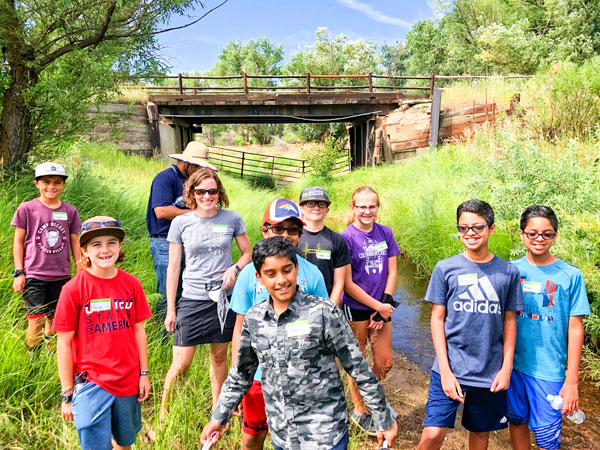Douglas County Conservation District promotes sustainability
By Lisa Nicklanovich; photo courtesy of Bill Vanderpoel

A group of students with the Douglas County Conservation District youth camp restore water flow at East Plum Creek as part of the Colorado Agricultural Leadership Foundation (CALF), located at Lowell Ranch.
The Douglas County Conservation District (DCCD) is on a mission to promote projects through education, furthering the sustainable use of natural resources with a goal to balance the needs of agriculture and urban growth.
Bill Vanderpoel, member of the volunteer board of supervisors said, “The large landowners know us, but we want those with smaller lots to know what we do. I view suburbia as the wild frontier of conservation because you can do a lot on a very small, typical suburban lot.”
What can you do with a small yard? Vanderpoel exclaimed, “You can create a pollinator garden; you can grow good wholesome food; you can conserve water.” The DCCD can provide rainwater harvesting information as well as suggestions for how to move away from a “sterile” lawn to a healthier ecosystem. Vanderpoel gave an example of a resident who planted native shrubs and plants which encouraged birds and multiple species of native bees to her yard (see thebeeswaggle.com for more information).
As a way to provide native plants and expertise, the DCCD has an annual plant sale which is happening now — online orders can be placed until April 6. The proceeds get reinvested in conservation initiatives.
With youth conservation workshops, camps and classroom curriculum, the DCCD educates children about where their food actually comes from and encourages an interest in getting outside.
At a kid’s camp over the summer, kids stood in the creek with nets and caught crustaceans, invertebrates and fish, learning from fish and wildlife experts. The DCCD also partnered with the Douglas County School District’s Office of Sustainability and helped Acres Green Elementary School build birdhouses to attract bluebirds. Vanderpoel said, “If you have an interest in a project, contact us and we’ll help you realize it.”
After a successful grant writing campaign, the DCCD was able to take on a big creek restoration project located at the historic Lowell Ranch in Castle Rock. East Plum Creek had channelized because of land development and hard surfaces. Vanderpoel explained, “You want water that is slow and meandering, which seeps into the ground, creating wildlife habitat so you have a broader riparian zone creating diversity.”
What the DCCD is most excited about is partnering with the community. Scout troops, youth groups, students seeking community service hours and corporate groups looking for volunteer opportunities are all encouraged to contact the DCCD. “We see it time and again; you get people out there digging and planting and it becomes different,” Vanderpoel said.
The West Plum Creek soil erosion district was established in 1940 as part of the 1935 Soil Conservation Act that was passed by Congress to provide assistance to farmers and ranchers that were hard hit from the Dust Bowl. In 1960, the district was consolidated with the Cherry Creek Soil Conservation District and formed what is now the DCCD.
For more information about DCCD, visit www.douglasconserves.org. To order from the annual plant sale click the “Shop” tab located on the home page. To volunteer, email District Manager Heather Kelly at DCCDistrict@gmail.com.